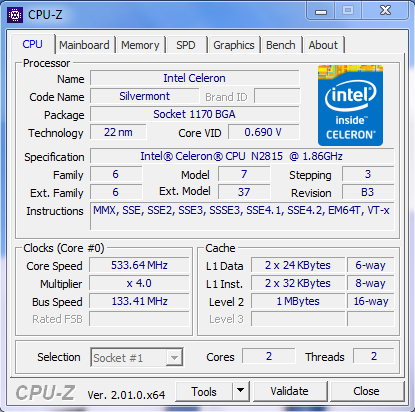Comparing: AMD A6-3400M vs Intel Celeron N2815
In this comparison, we analyze two Processors: AMD A6-3400M and Intel Celeron N2815, using synthetic benchmark tests to evaluate their overall performance. This side-by-side comparison helps users understand which hardware delivers better value, speed, and efficiency based on standardized testing. Whether you're building a new system or upgrading an existing one, this benchmark-driven evaluation offers valuable insights to guide your decision.

Intel Celeron N2815
| Type: | Processors |
|---|---|
| Brand: | Intel |
| Model: | Celeron N2815 |
Specification Comparison Table
This specification comparison presents technical details of several devices or components to help you understand the key differences between each option. Use this table as a reference to determine which device best suits your needs.
| Specification | AMD A6-3400M | Intel Celeron N2815 |
|---|---|---|
| Architecture | x86 | x86 |
| Technology | 32 nm | 22 nm |
| Clock | 1.4 GHz - 2.3 GHz | 1.86 GHz - 2.13 GHz |
| Core/Thread | 4 / 4 | 2 / 2 |
| Segmen | Mobile | Mobile |
Submission Comparison Table
This submission comparison table displays the number and details of benchmark data submissions from various devices or components. This information helps you understand the performance based on the benchmarks that have been tested, as well as providing an overview of the consistency and popularity of the available benchmark results.
| No. | Benchmark Software | AMD A6-3400M | Intel Celeron N2815 |
|---|---|---|---|
| 1 | PiFast |
1min, 14sec, 310ms |
1min, 28sec, 750ms |
| 2 | SuperPi - 1M |
46sec, 984ms |
40sec, 513ms |
| 3 | wPrime - 32M |
27sec, 142ms |
47sec, 267ms |
Submission Comparison Chart
This chart visualizes the benchmark scores comparison between two hardware devices based on submitted data.
Media Gallery
A collection of photos of tested hardware. These images can help you identify the physical form, model, and variant of the hardware in question. These photos are from our own documentation, and if they are not available we may not be able to document them.
About Hardware AMD A6-3400M
Released in mid-2011, the AMD A6-3400M is a mobile processor from the Llano family designed for the mid-range laptop segment. It has 4 cores and 4 threads with a base speed of 1.4 GHz that can increase to 2.3 GHz thanks to AMD's Turbo Core technology. Carrying a 32nm fabrication process, the A6-3400M offers good power efficiency with a TDP of 35W, making it a popular choice among conventional laptop users at the time. The main advantage of this processor lies not only in having enough cores for light multitasking, but also in the integration of an onboard GPU, the AMD Radeon HD 6520G. This GPU has 320 shader cores based on the Terascale 2 architecture, which is capable enough to run light graphics applications to older games with low resolution and graphics quality settings. The combination of CPU and GPU in one chip is designed to provide a balance between computing and graphics performance in one energy-efficient package.
In terms of performance, the A6-3400M can handle everyday computing needs such as browsing the internet, watching videos, listening to music, typing documents, and other light productivity tasks. However, in heavier usage scenarios or multitasking with many applications open at once, its performance starts to show limitations, especially when combined with a small RAM capacity such as 2GB. When compared to the same generation of Intel Core i3 processors, the A6-3400M does lag behind in single-thread performance, which is an important aspect for running modern applications that are not fully optimized for multi-core. In tests on a Lenovo Sabine B475 device with 2GB DDR3 RAM and Windows 7 operating system, the A6-3400M's performance showed that it is still quite responsive for light use, although it is no longer ideal for today's heavier workloads. Even so, the A6-3400M is still an attractive option for users who want a budget laptop with basic multimedia capabilities and a decent user experience for everyday needs.
Hardware Tested:
Device: Lenovo Sabine B475
RAM: 2GB DDR3
OS: Windows 7
Thursday, 24 November 2022 05:29:20 | Update: 1 month ago
About Hardware Intel Celeron N2815
The Intel Celeron N2815 is a power-efficient processor released in 2013 as part of the Bay Trail-M family, aimed at entry-level laptops and lightweight computing devices. It has 2 cores and 2 threads with a base speed of 1.86 GHz that can increase to 2.13 GHz thanks to Intel Burst Performance technology. Built using a 22nm fabrication process, the N2815 comes with a TDP of only 7.5 watts, making it one of Intel's most efficient processors in terms of power consumption for the low-end class. This makes it very suitable for portable devices such as netbooks or mini laptops that prioritize battery life over high performance.
On the graphics side, the Intel Celeron N2815 is equipped with an integrated Intel HD Graphics (Bay Trail) GPU that runs at a base frequency of 313 MHz and can reach up to 756 MHz under certain conditions. This GPU is capable enough to run desktop displays smoothly, and supports 720p video playback. However, for heavy graphics tasks such as playing modern 3D games, video editing, or graphic design, this GPU is clearly not capable. Its use is more suitable for everyday computing such as opening documents, browsing the internet, playing standard videos, and running light office applications.
In terms of overall performance, the Celeron N2815 is sufficient for running light operating systems such as Windows 7 or light-based Linux distributions such as Lubuntu or Linux Mint XFCE. However, due to its simple architecture and low single-threaded performance, users may experience limitations when running multiple applications at once or when opening software that requires higher computing power. In tests using an Asus X200MA laptop with 2GB DDR3 dual channel RAM and Windows 7 operating system, performance was good enough for basic use, although it was slow when running modern applications or multitasking.
Overall, the Intel Celeron N2815 is a decent processor for light computing needs with low power consumption and an economical price, but it is not recommended for heavy productivity tasks or long-term use on modern operating systems.
Hardware Detail:
Device: Asus X200MA
RAM: 2GB Dual Channel
OS: Windows 7
Saturday, 07 May 2022 13:02:41 | Update: 1 month ago


